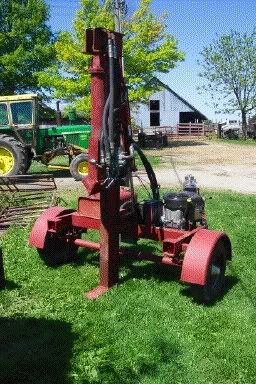I was thinking about the requisite tonnage for a splitter in trying to decide how large of a cylinder is necessary (trying to reduce cycle time). Two thoughts came to mind
First, does the stroke length affect the tonnage required? I know that the diameter of the piston ultimately determines the tonnage of the ram, but my thought was that shorter pieces of wood may require less force. An example is probably the best way to explain this idea. On a very short log, say 10", the wedge quickly "pops" the wood. On longer wood of 26", the wedge takes longer to "pop" the log in half. In essence, the ram is being used to pry the log in half. If the length of the log is decreased, the amount of area that is exposed in the splitting process (i.e. the areas of the two split sections that used to be in contact with one another when they were part of the log) is also decreased. I would think that each unit of area requires a certain amount of force to separate. Is this accurate? Would a decrease in wood length decrease the amount of tonnage needed?
Secondly, it seems farily obvious that the length of the cutting edge is also fairly important in determining the tonnage required for a splitter; more edge length, more tonnage. Does anyone know if this is a direct relationship (i.e. a 12" wedge will require 50% more tonnage than an 8" wedge) or if the force required per inch of wedge decreases or increases with an increase in total wedge length? Also, by what factor is this increased (or decreased) when a more complex wedge, that splits logs 4, 6 or 8 ways is used?
I read in another post that angling the top of the wedge into the wood helps to reduce the initial strain on the splitter, which makes sense, but I wonder to what extent.
Thanks for the input
First, does the stroke length affect the tonnage required? I know that the diameter of the piston ultimately determines the tonnage of the ram, but my thought was that shorter pieces of wood may require less force. An example is probably the best way to explain this idea. On a very short log, say 10", the wedge quickly "pops" the wood. On longer wood of 26", the wedge takes longer to "pop" the log in half. In essence, the ram is being used to pry the log in half. If the length of the log is decreased, the amount of area that is exposed in the splitting process (i.e. the areas of the two split sections that used to be in contact with one another when they were part of the log) is also decreased. I would think that each unit of area requires a certain amount of force to separate. Is this accurate? Would a decrease in wood length decrease the amount of tonnage needed?
Secondly, it seems farily obvious that the length of the cutting edge is also fairly important in determining the tonnage required for a splitter; more edge length, more tonnage. Does anyone know if this is a direct relationship (i.e. a 12" wedge will require 50% more tonnage than an 8" wedge) or if the force required per inch of wedge decreases or increases with an increase in total wedge length? Also, by what factor is this increased (or decreased) when a more complex wedge, that splits logs 4, 6 or 8 ways is used?
I read in another post that angling the top of the wedge into the wood helps to reduce the initial strain on the splitter, which makes sense, but I wonder to what extent.
Thanks for the input





